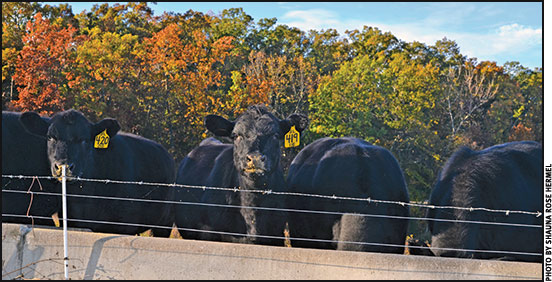
Manage the Details
Management factors affect the efficiency of reproductive technologies.
Estrus synchronization and artificial insemination (AI) have been called the most powerful and applicable technologies for genetic improvement. According to George Perry, a reproductive physiologist and South Dakota State University animal science professor, synchronized AI has become more practical than ever due to the identification of beef sires with highly accurate expected progeny differences (EPDs) and a cattle market structure that can reward producers for quality. Additionally, synchronized AI is more practical because of advancements in estrus-synchronization protocols.

Studies suggest that when estrus is observed, followed by insemination at the right time and with semen deposited in the right place, fertilization occurs 95% of the time, said George Perry, a reproductive physiologist and South Dakota State University.
Speaking at the Applied Reproductive Strategies in Beef Cattle (ARSBC) symposium hosted Aug. 17-18 in Davis, Calif., Perry reminded the audience that successful implementation of synchronized AI still hinges on good management. That means tending to the details — all of the details.
“The things you do well will not compensate for the mistakes you make,” said Perry. “Instead, the mistakes you make cancel out the things you do well.”
While discussing the things a producer should consider before implementing a synchronized AI program, Perry said cattlemen should first decide whether their breeding herd is ready for the introduction of reproductive technology. He advised producers to consider what their herds’ pregnancy rates have been during recent years. If, at the end of a 60- to 80-day breeding season, the pregnancy rate is less than 85%, then there may be management issues to address before introducing synchronized AI.
Pick good candidates
Perry said both cows and heifers should be scrutinized for their suitability. Heifers should have been adequately developed prior to breeding. Perry favors the rule-of-thumb calling for heifers to attain 65% of their expected mature weight by the beginning of breeding season. Breeding heifer candidates should not have received any growth-promoting implants. The sexual maturity of candidates can be determined through reproductive tract examination performed four to six weeks prior to breeding season. No less than 50% of the heifers should have started normal estrous cycles.
According to Perry, postpartum cows most apt to be good candidates for synchronized AI will have had a body condition score at calving of at least 5 on a 9-point scale, and the mean postpartum interval of the candidate group should be 40 days or greater. If the chosen protocol includes the use of controlled internal drug release (CIDR®) devices, each cow should be a minimum of 21 days postpartum at the time of CIDR insertion.
Regarding management of health through vaccination against disease, Perry said heifer candidates should have been vaccinated twice as calves — once prior to weaning and again at weaning. Boosters should be administered to heifers and cows at least 30 days prior to the breeding season. Use of a modified-live virus (MLV) product should not be used at prebreeding unless animals were vaccinated previously with an MLV vaccine.
Follow the protocol
Perry emphasized that regardless of which synchronization protocol is selected, it must be implemented precisely. The prescribed timing and dosage of synchronization products must be followed carefully, along with properly timed insemination using proper technique. However, when choosing a synchronization protocol, producers must first determine whether they want to use estrus (heat) detection and inseminate according the a.m./p.m. rule, inseminate all females at a predetermined time (fixed-time AI, or FTAI) or detect estrus for 72 to 84 hours (depending on protocol used) followed by FTAI of any females not inseminated after observation of estrus.
Studies suggest that when estrus is observed, followed by insemination at the right time and with semen deposited in the right place, fertilization occurs 95% of the time. Perry said this information surprises many producers, since pregnancy rate at the earliest possible detection (Day 27) is often less than 70%. Therefore many “opens” are the result of embryo loss. Perry emphasized the importance of managing factors that threaten the very early stages of pregnancy.
Prevent embryo loss
Factors responsible for increased embryo mortality include the stress of handling, particularly shipping.
Perry said transporting females between five and 42 days after insemination can cause a 10% decrease in pregnancy rate. Research has also demonstrated that shipping cattle 45 to 60 days after insemination may result in 6% embryo mortality.
“Shipping between Days 1 and 4 is best, because the embryo is still in the oviduct and not susceptible to uterine changes brought on by shipping stress,” advised Perry. “Also, after Day 45 the embryo is well-established and fully attached to the placenta, and shipping is less risky.”
Perry said the risk of embryo loss also is higher when cows or heifers experience stress due to high temperature and humidity. However, change in nutritional status may be the most common factor influencing embryo survival. Perry said any abrupt change in diet poses a risk to maintaining pregnancy.
As an example, Perry cited the common practice of developing heifers in confinement until breeding time and then turning them onto pasture soon or immediately after insemination. Such heifers are likely unaccustomed to grazing and are forced to eat a novel diet. They expend considerable energy and experience inadequate energy intake until they become acclimated to the new environment. Perry said making the shift from drylot and a prepared ration to pasture at least 30 days prior to breeding would prevent heifers from experiencing multiple forms of stress at the time of breeding.
“Maintaining consistency of management during the breeding season is extremely important to achieving optimum pregnancy rates,” concluded Perry.
Perry spoke during Monday’s ARSBC session focused on field experiences. Visit the Newsroom at www.appliedreprostrategies.com to view his PowerPoint, read the proceedings or listen to his presentation.

Editor’s Note: Troy Smith is a freelance writer and cattleman from Sargent, Neb. Comprehensive coverage of the symposium is available online at www.appliedreprostrategies.com. Compiled by the Angus Journal editorial team, the site is made possible through sponsorship by the Beef Reproduction Task Force.





